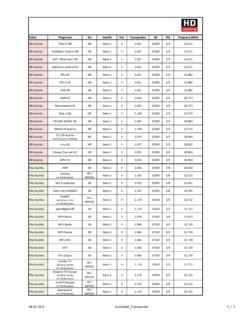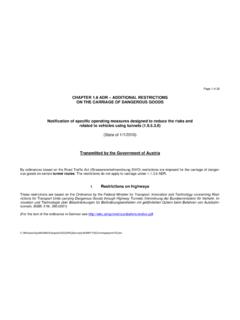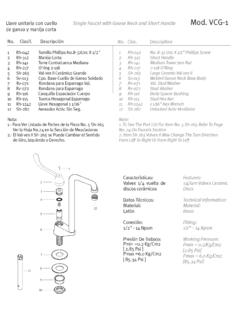Transcription of Energy efficiency trends and policies in Austria
1 Energy efficiency trends and policies in Austria Date: June 2018. Contact person: Reinhard Jellinek, Austrian Energy Agency, Austria Energy efficiency trends and policies in Austria 1. The sole responsibility for the content of this publication lies with the authors. It does not necessarily reflect the opinion of the European Communities. The European Commission is not responsible for any use that may be made of the information contained therein. Energy efficiency trends and policies in Austria 2. TABLE OF CONTENT. TABLE OF CONTENT .. 3. LIST OF 4. EXECUTIVE SUMMARY .. 6. 1. ECONOMIC AND Energy efficiency CONTEXT .. 7. Economic context ..7. Total Energy consumption and intensities ..8. Energy efficiency policy background .. 14. Energy efficiency 16. Energy efficiency IN BUILDINGS .. 19. Energy efficiency trends .. 19. Energy efficiency policies .. 23. 2. Energy EFFIENCY IN TRANSPORT .. 25. Energy efficiency trends .
2 25. Energy efficiency policies .. 31. 3. Energy efficiency IN INDUSTRY .. 34. Energy efficiency trends .. 34. Energy efficiency policies .. 37. Energy efficiency trends and policies in Austria 3. LIST OF FIGURES. Figure 1: Macroeconomic development (M 2010) .. 8. Figure 2: Final Energy consumption by sector 2000 2016. The figures for residential consumption are adjusted for climatic influences.. 9. Figure 3: Final Energy consumption by Energy : 2000 and 2016 .. 10. Figure 4: Index of primary and final Energy intensity of the Austrian economy (climate corrected).. 11. Figure 5: Final Energy intensity (structural effect) .. 12. Figure 6: Energy intensity in selected sectors from 2000 to 2016 .. 12. Figure 9: ODEX Energy efficiency indices by sector from 2000 to 2016 .. 14. Figure 10: Total residential Energy demand by fuel type from 2000 to 2016 .. 19. Figure 11: Percentage of residential Energy demand by fuel type: 2000 and 2016.
3 20. Figure 12: Energy consumption by types of end-use: 2000 and 2016 .. 21. Figure 13: Variation households consumption for space heating - Austria - Mtoe (2000-2016) .. 22. Figure 14: Development of total Energy usage, Energy usage for space heating and electricity usage per dwelling (all climate corrected) in the residential sector from 2000 to 2016 .. 23. Figure 15: Passenger travel by transport modes .. 25. Figure 16: Freight traffic by transport mode .. 26. Figure 17: Transport: Energy consumption by mode 2000-2016 .. 27. Figure 16: Transport: Percentage of Energy consumption by mode 2000 and 2016 .. 28. Figure 17: Road transport: Energy consumption by vehicle type .. 28. Figure 20: Road transport: Energy consumption by vehicle type and border trade 2000-2016 .. 29. Figure 21: Energy intensity in transport from 2000 to 2016 .. 30. Figure 22: Variation transport consumption (2000-2016).
4 31. Figure 23: Energy consumption shares of branches of manufacturing: 2000 and 2016 .. 34. Figure 24: Energy consumption in manufacturing and in construction and mining: 2000 - 35. Figure 25: Energy consumption of the branches of manufacturing: 2000 2016 .. 36. Figure 26: Variation of industry Energy consumption 2000 - 2016 .. 37. Energy efficiency trends and policies in Austria 4. List of tables Table 1: Residential Energy demand by fuel type: 2000 and 2016 .. 20. Table 2: Freight traffic by modes of transport: 2000, 2007 (peak year until 2015) and 2016 .. 26. Energy efficiency trends and policies in Austria 5. EXECUTIVE SUMMARY. In 2016, Austria 's final Energy consumption amounted to 1, PJ a increase compared to 2000. The main drivers for the increase are a rise in final Energy consumption in the transport sector (+ ) and consumption in the industry sector (+ ) over this period. Final consumption also rose in the residential sector (+ ).
5 However, final consumption of households, which is adjusted for climatic influences, remained stable in the period under review ( ). In 2016, the transport sector had the highest share of total final consumption with , slightly followed by the industry sector with a share of in final Energy consumption. Private households recorded a share of , services and agriculture In Austria fossil fuels are the main Energy source: oil is number one with a share of of gross domestic consumption, followed by gas ( ) and coal ( ). The obligation to add more biofuels to fossil fuels and the increased generation of district heating from biomass have resulted in a record high use of renewable Energy sources in Austria . Renewable Energy sources account for gross domestic consumption, with solid biomass being the most important renewable Energy source (39%), followed by hydro power (33%). Other renewable Energy sources include solar, wind, geothermal Energy , biogas and biofuels with a share lower than 5% each.
6 Austria has adopted a policy that rules out the use of nuclear Energy in its Energy mix. Electricity consumption continues to rise. In 2016 final electricity consumption amounted to 61,851 GWh, an increase by compared with 2000. The Energy intensities (climate corrected) do not show very substantial changes in the period 2000- 2016: Primary Energy intensity fell by , while final Energy intensity decreased by Overall Energy efficiency (ODEX indicator) improved by 20% between 2000 and 2016. Most of the efficiency improvements were achieved in the households (32%) and tertiary (30%) sectors. Energy efficiency in the industry sector rose by 16%, and by 9% in the transport sector. In general, it can be stated that improvements in Energy efficiency have been partly offset or even exceeded by higher levels of activity. For example, the transport performance of passenger transport in cars (pkm) has risen by 21%.
7 The transport performance of freight transport (road + rail + river) has increased by 34%. The stock of cars increased by 26% and freight traffic on road (tkm) increased by 37% between 2000 and 2016. Thus, the enhanced engine technology of vehicles is offset by an increase in transport performance. Furthermore, the stock of permanently occupied dwellings (+18%), the average floor area of dwellings (+10%) and the saturation rate of electrical household appliances (dish-washers: +73%, dryers: +190%) and new technical features such as air conditioning (+336%) counteract the positive effects of more efficient buildings. The Austrian government assumes that fuel tourism with vehicles from neighboring countries taking advantage of the comparatively lower tax rate for transport fuels, accounts for much of this increase in the transport sector. It is estimated that net fuel tourism accounted for roughly 23% of total diesel and petrol sold in Austria in 2016.
8 Energy efficiency trends and policies in Austria 6. 1. ECONOMIC AND Energy efficiency CONTEXT. ECONOMIC CONTEXT. Chart shows the long-term trends of the main macroeconomic indicators GDP, private consumption and value added of industry. In 2016, Austria 's GDP in current national currency amounted to thousand million euros. The average growth rate of the GDP has been per year since 2000, with the years of highest growth being 2007 ( ) and 2006 ( ). The average growth rate in the 1990s was considerably higher with In 2009, the global economy suffered shrinkage for the first time in many decades, caused by the international financial crisis. The Austrian economy did not escape the downward trend and experienced a negative growth rate of in 2009. This was the only decrease in GDP in current national currency in a year-on-year comparison since 1976. As a small open economy, Austria had entered a recession caused primarily by falling exports, reflecting the collapse of world trade and shrinking investment.
9 In 2010, the world economy had overcome the cyclical downturn. The Austrian economy, led by a dynamic export growth, recovered modestly with a GDP growth rate of However, the fiscal consolidation in the euro area and weak competitiveness of the southern European economies began to weigh on aggregate demand since 2011. A similar development as for the total economy was observed in the industry sector: Value added at current market prices of industry increased by an average growth rate of around per year in the period 2000-2016. The record growth rate was recorded in 2007 with In 2009, industry had to face a significant recession with a decrease of the value added at a rate of The collapse in the prices for raw materials and weak demand for some time has depressed the general price level. By 2016, the value added has grown again at compared to 2009. a. In the year 2016, growth stood at The private consumption of households (in current national currency) saw an average annual growth of per year in the period from 2000 to 2016.
10 In the recession (2009), private consumption rose by Energy efficiency trends and policies in Austria 7. Figure 1: Macroeconomic development (M 2010). Source: Statistics Austria GDP. Private consumption Value added of industry M . 0. 2000 2001 2002 2003 2004 2005 2006 2007 2008 2009 2010 2011 2012 2013 2014 2015 2016. TOTAL Energy CONSUMPTION AND INTENSITIES. Energy Consumption Final Energy consumption (climate corrected) rose by in the period from 2000 to 2016. Figure 2 displays the steady growth trend until 2008. In the period 2000 2008 the mean annual growth of total final consumption was In the recession year 2009, total final Energy consumption decreased by At , the largest reduction for the year 2009 is observed for industry consumption. An average annual growth rate for final consumption of is observed for the period 2010-2016. Energy efficiency trends and policies in Austria 8. Figure 2: Final Energy consumption by sector 2000 2016.









